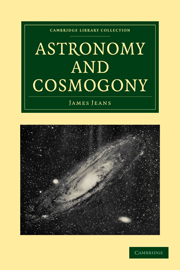Book contents
- Frontmatter
- Contents
- LIST OF ILLUSTRATIONS
- PREFACE
- CHAP. I The Astronomical Survey of the Universe
- CHAP. II The Light from the Stars
- CHAP. III Gaseous Stars
- CHAP. IV The Source of Stellar Energy
- CHAP. V Liquid Stars
- CHAP. VI The Evolution of the Stars
- CHAP. VII Non-spherical Masses–Dynamical Principles
- CHAP. VIII The Configurations of Rotating Liquid Masses
- CHAP. IX The Configurations of Rotating Compressible Masses
- CHAP. X Rotation and Fission of Stars
- CHAP. XI The Evolution of Binary Systems
- CHAP. XII The Ages of the Stars
- CHAP. XIII The Great Nebulae
- CHAP. XIV The Galactic System of Stars
- CHAP. XV Variable Stars
- CHAP. XVI The Solar System
- CHAP. XVII Conclusion
- Index of Subjects
- Index of Names
CHAP. II - The Light from the Stars
Published online by Cambridge University Press: 07 September 2010
- Frontmatter
- Contents
- LIST OF ILLUSTRATIONS
- PREFACE
- CHAP. I The Astronomical Survey of the Universe
- CHAP. II The Light from the Stars
- CHAP. III Gaseous Stars
- CHAP. IV The Source of Stellar Energy
- CHAP. V Liquid Stars
- CHAP. VI The Evolution of the Stars
- CHAP. VII Non-spherical Masses–Dynamical Principles
- CHAP. VIII The Configurations of Rotating Liquid Masses
- CHAP. IX The Configurations of Rotating Compressible Masses
- CHAP. X Rotation and Fission of Stars
- CHAP. XI The Evolution of Binary Systems
- CHAP. XII The Ages of the Stars
- CHAP. XIII The Great Nebulae
- CHAP. XIV The Galactic System of Stars
- CHAP. XV Variable Stars
- CHAP. XVI The Solar System
- CHAP. XVII Conclusion
- Index of Subjects
- Index of Names
Summary
STELLAR MAGNITUDES AND LUMINOSITIES.
The ancients thought of the stars as luminous points immovably attached to a spherical shell which covered in the flat earth much as a telescope-dome covers in the telescope, so that when one star differed from another in glory, it was not because the two stars were at different distances from us, but because one was intrinsically more luminous than the other.
Hipparchus introduced the conception of “magnitude” as measuring the brightnesses of the stars, and Ptolemy, in his Almagest, divided the stars into six groups of six different magnitudes. The 20 brightest stars formed the first magnitude stars, while stars which were only just visible to the eye were the sixth magnitude stars. Thus Ptolemy regarded the differences of visible glory as being represented by five steps, each step down being represented as an increase of one magnitude.
According to the well-known physiological law of Fechner, the effect which any cause produces on our senses is proportional to the logarithm of the cause. If we can just, and only just, appreciate the difference between 10 and 11, we shall not notice any difference at all between 20 and 21, but shall just be able to detect the difference between 20 and 22, or between 5 and 5½. Our senses do not supply us with a direct estimate of the intensity of the phenomenon which is affecting them, but of its logarithm.
- Type
- Chapter
- Information
- Astronomy and Cosmogony , pp. 30 - 63Publisher: Cambridge University PressPrint publication year: 2009First published in: 1928



